Organizational Behavior Analysis: M&S Culture, Politics, and Power
VerifiedAdded on 2020/11/12
|10
|3295
|233
Report
AI Summary
This report delves into the realm of organizational behavior, focusing on the influence of culture, politics, and power on individual and team performance within the context of M&S. It analyzes how these factors shape employee behavior and contribute to the achievement of organizational goals. The report further evaluates content and process theories of motivation, exploring their application in enhancing employee engagement and productivity. It examines motivational techniques and their effectiveness in achieving organizational objectives. The analysis includes an assessment of how to influence behavior through the strategic application of behavioral motivational theories, concepts, and modes, providing valuable insights into fostering a positive and productive work environment within M&S. The report highlights the interplay between organizational dynamics and employee motivation, offering practical recommendations for fostering a successful organizational culture.
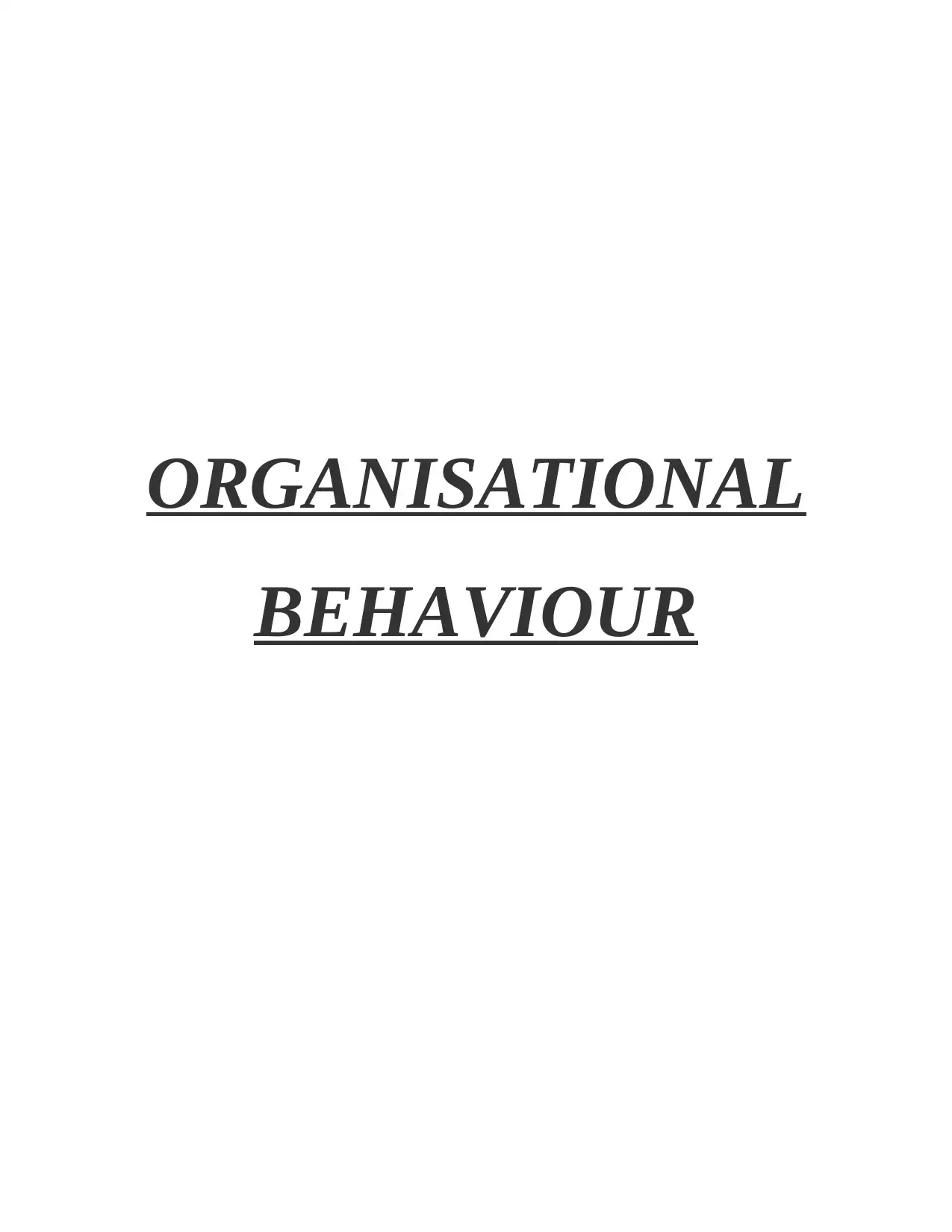
ORGANISATIONAL
BEHAVIOUR
BEHAVIOUR
Paraphrase This Document
Need a fresh take? Get an instant paraphrase of this document with our AI Paraphraser
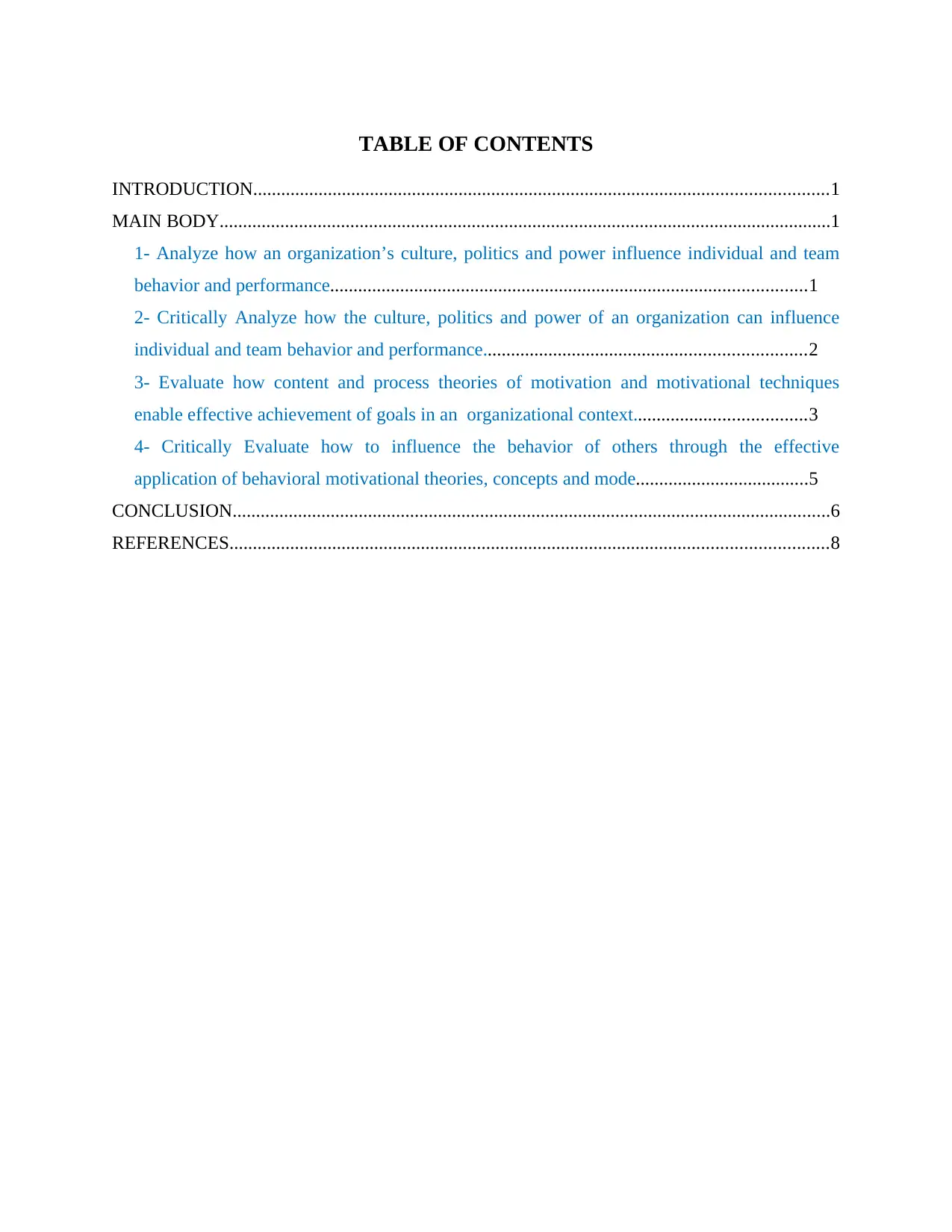
TABLE OF CONTENTS
INTRODUCTION...........................................................................................................................1
MAIN BODY...................................................................................................................................1
1- Analyze how an organization’s culture, politics and power influence individual and team
behavior and performance......................................................................................................1
2- Critically Analyze how the culture, politics and power of an organization can influence
individual and team behavior and performance.....................................................................2
3- Evaluate how content and process theories of motivation and motivational techniques
enable effective achievement of goals in an organizational context.....................................3
4- Critically Evaluate how to influence the behavior of others through the effective
application of behavioral motivational theories, concepts and mode.....................................5
CONCLUSION................................................................................................................................6
REFERENCES................................................................................................................................8
INTRODUCTION...........................................................................................................................1
MAIN BODY...................................................................................................................................1
1- Analyze how an organization’s culture, politics and power influence individual and team
behavior and performance......................................................................................................1
2- Critically Analyze how the culture, politics and power of an organization can influence
individual and team behavior and performance.....................................................................2
3- Evaluate how content and process theories of motivation and motivational techniques
enable effective achievement of goals in an organizational context.....................................3
4- Critically Evaluate how to influence the behavior of others through the effective
application of behavioral motivational theories, concepts and mode.....................................5
CONCLUSION................................................................................................................................6
REFERENCES................................................................................................................................8
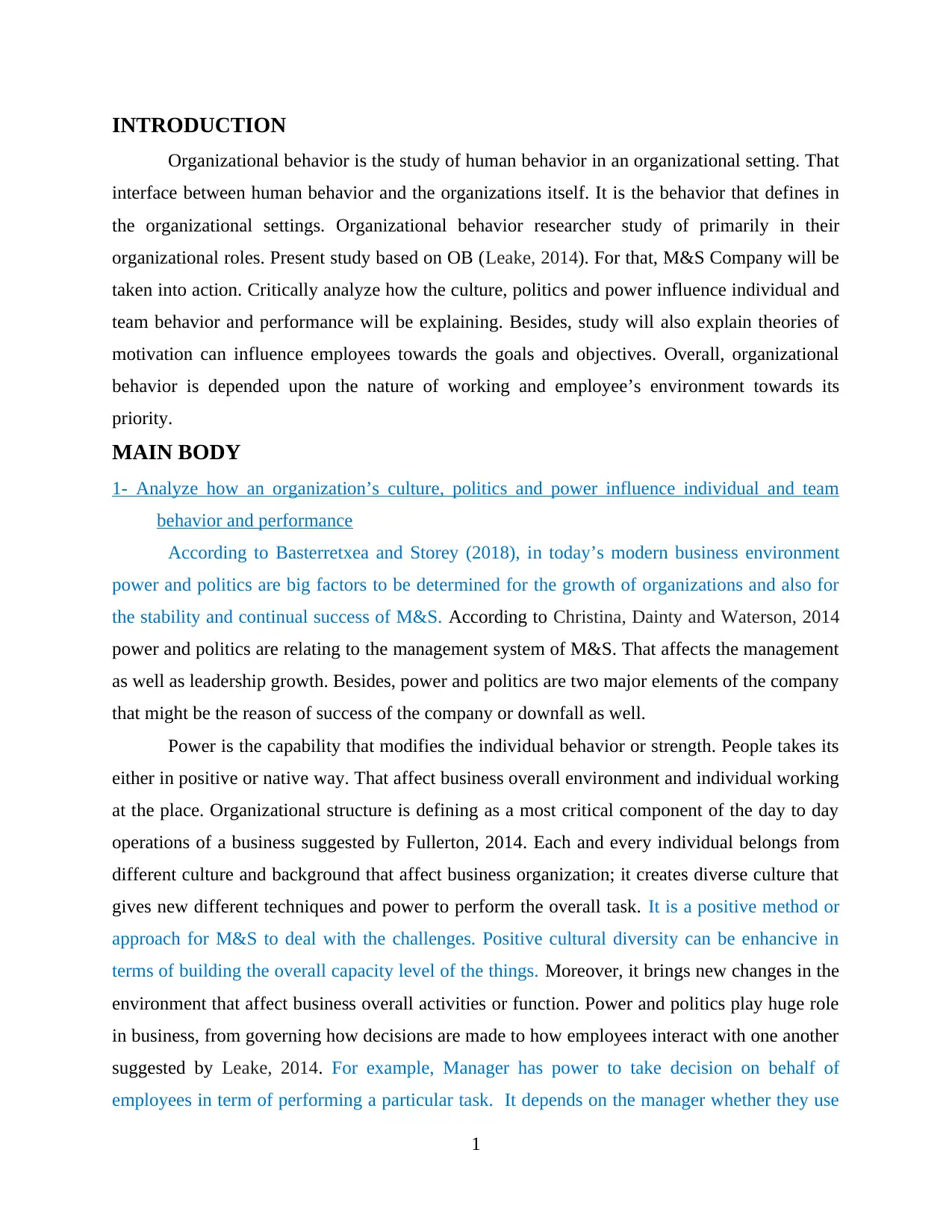
INTRODUCTION
Organizational behavior is the study of human behavior in an organizational setting. That
interface between human behavior and the organizations itself. It is the behavior that defines in
the organizational settings. Organizational behavior researcher study of primarily in their
organizational roles. Present study based on OB (Leake, 2014). For that, M&S Company will be
taken into action. Critically analyze how the culture, politics and power influence individual and
team behavior and performance will be explaining. Besides, study will also explain theories of
motivation can influence employees towards the goals and objectives. Overall, organizational
behavior is depended upon the nature of working and employee’s environment towards its
priority.
MAIN BODY
1- Analyze how an organization’s culture, politics and power influence individual and team
behavior and performance
According to Basterretxea and Storey (2018), in today’s modern business environment
power and politics are big factors to be determined for the growth of organizations and also for
the stability and continual success of M&S. According to Christina, Dainty and Waterson, 2014
power and politics are relating to the management system of M&S. That affects the management
as well as leadership growth. Besides, power and politics are two major elements of the company
that might be the reason of success of the company or downfall as well.
Power is the capability that modifies the individual behavior or strength. People takes its
either in positive or native way. That affect business overall environment and individual working
at the place. Organizational structure is defining as a most critical component of the day to day
operations of a business suggested by Fullerton, 2014. Each and every individual belongs from
different culture and background that affect business organization; it creates diverse culture that
gives new different techniques and power to perform the overall task. It is a positive method or
approach for M&S to deal with the challenges. Positive cultural diversity can be enhancive in
terms of building the overall capacity level of the things. Moreover, it brings new changes in the
environment that affect business overall activities or function. Power and politics play huge role
in business, from governing how decisions are made to how employees interact with one another
suggested by Leake, 2014. For example, Manager has power to take decision on behalf of
employees in term of performing a particular task. It depends on the manager whether they use
1
Organizational behavior is the study of human behavior in an organizational setting. That
interface between human behavior and the organizations itself. It is the behavior that defines in
the organizational settings. Organizational behavior researcher study of primarily in their
organizational roles. Present study based on OB (Leake, 2014). For that, M&S Company will be
taken into action. Critically analyze how the culture, politics and power influence individual and
team behavior and performance will be explaining. Besides, study will also explain theories of
motivation can influence employees towards the goals and objectives. Overall, organizational
behavior is depended upon the nature of working and employee’s environment towards its
priority.
MAIN BODY
1- Analyze how an organization’s culture, politics and power influence individual and team
behavior and performance
According to Basterretxea and Storey (2018), in today’s modern business environment
power and politics are big factors to be determined for the growth of organizations and also for
the stability and continual success of M&S. According to Christina, Dainty and Waterson, 2014
power and politics are relating to the management system of M&S. That affects the management
as well as leadership growth. Besides, power and politics are two major elements of the company
that might be the reason of success of the company or downfall as well.
Power is the capability that modifies the individual behavior or strength. People takes its
either in positive or native way. That affect business overall environment and individual working
at the place. Organizational structure is defining as a most critical component of the day to day
operations of a business suggested by Fullerton, 2014. Each and every individual belongs from
different culture and background that affect business organization; it creates diverse culture that
gives new different techniques and power to perform the overall task. It is a positive method or
approach for M&S to deal with the challenges. Positive cultural diversity can be enhancive in
terms of building the overall capacity level of the things. Moreover, it brings new changes in the
environment that affect business overall activities or function. Power and politics play huge role
in business, from governing how decisions are made to how employees interact with one another
suggested by Leake, 2014. For example, Manager has power to take decision on behalf of
employees in term of performing a particular task. It depends on the manager whether they use
1
⊘ This is a preview!⊘
Do you want full access?
Subscribe today to unlock all pages.

Trusted by 1+ million students worldwide
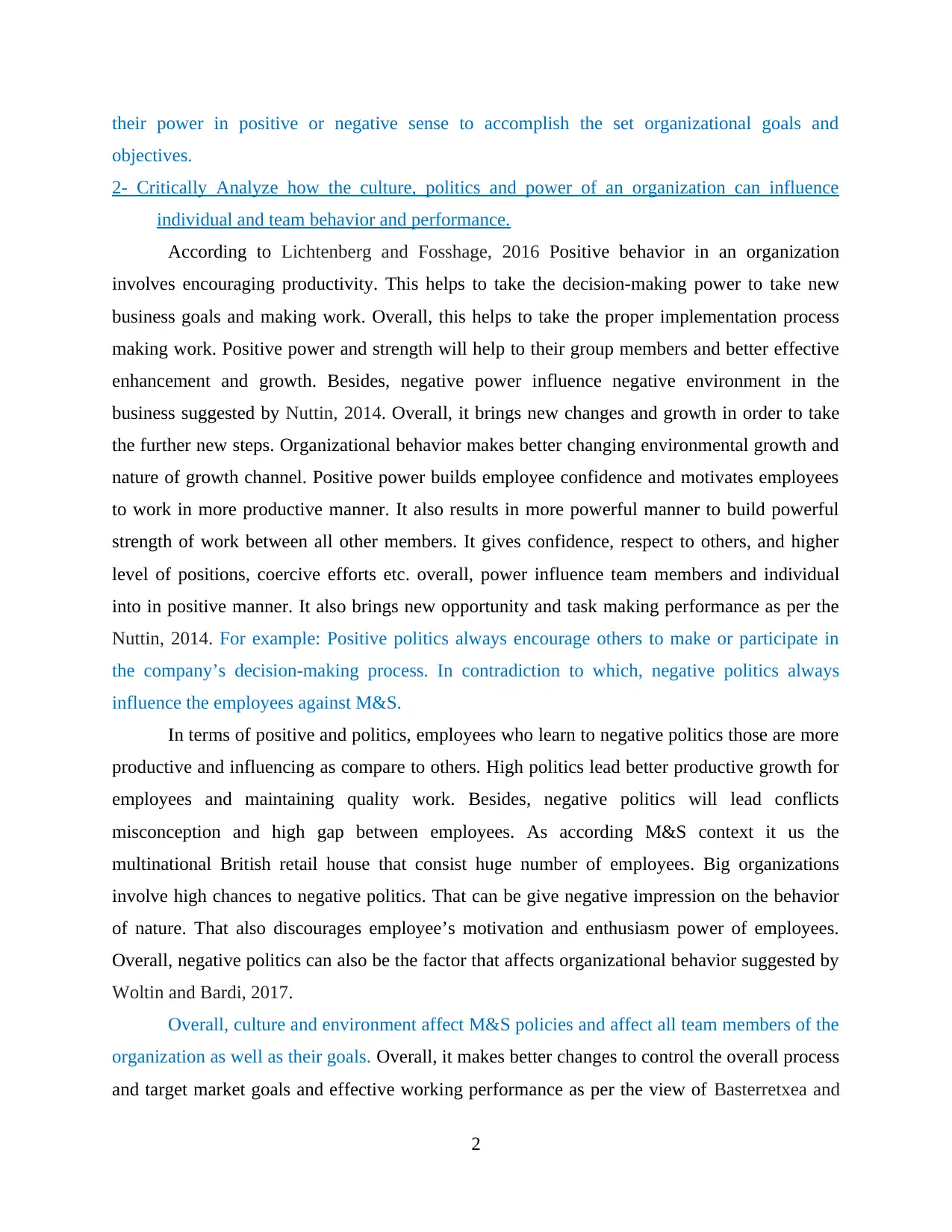
their power in positive or negative sense to accomplish the set organizational goals and
objectives.
2- Critically Analyze how the culture, politics and power of an organization can influence
individual and team behavior and performance.
According to Lichtenberg and Fosshage, 2016 Positive behavior in an organization
involves encouraging productivity. This helps to take the decision-making power to take new
business goals and making work. Overall, this helps to take the proper implementation process
making work. Positive power and strength will help to their group members and better effective
enhancement and growth. Besides, negative power influence negative environment in the
business suggested by Nuttin, 2014. Overall, it brings new changes and growth in order to take
the further new steps. Organizational behavior makes better changing environmental growth and
nature of growth channel. Positive power builds employee confidence and motivates employees
to work in more productive manner. It also results in more powerful manner to build powerful
strength of work between all other members. It gives confidence, respect to others, and higher
level of positions, coercive efforts etc. overall, power influence team members and individual
into in positive manner. It also brings new opportunity and task making performance as per the
Nuttin, 2014. For example: Positive politics always encourage others to make or participate in
the company’s decision-making process. In contradiction to which, negative politics always
influence the employees against M&S.
In terms of positive and politics, employees who learn to negative politics those are more
productive and influencing as compare to others. High politics lead better productive growth for
employees and maintaining quality work. Besides, negative politics will lead conflicts
misconception and high gap between employees. As according M&S context it us the
multinational British retail house that consist huge number of employees. Big organizations
involve high chances to negative politics. That can be give negative impression on the behavior
of nature. That also discourages employee’s motivation and enthusiasm power of employees.
Overall, negative politics can also be the factor that affects organizational behavior suggested by
Woltin and Bardi, 2017.
Overall, culture and environment affect M&S policies and affect all team members of the
organization as well as their goals. Overall, it makes better changes to control the overall process
and target market goals and effective working performance as per the view of Basterretxea and
2
objectives.
2- Critically Analyze how the culture, politics and power of an organization can influence
individual and team behavior and performance.
According to Lichtenberg and Fosshage, 2016 Positive behavior in an organization
involves encouraging productivity. This helps to take the decision-making power to take new
business goals and making work. Overall, this helps to take the proper implementation process
making work. Positive power and strength will help to their group members and better effective
enhancement and growth. Besides, negative power influence negative environment in the
business suggested by Nuttin, 2014. Overall, it brings new changes and growth in order to take
the further new steps. Organizational behavior makes better changing environmental growth and
nature of growth channel. Positive power builds employee confidence and motivates employees
to work in more productive manner. It also results in more powerful manner to build powerful
strength of work between all other members. It gives confidence, respect to others, and higher
level of positions, coercive efforts etc. overall, power influence team members and individual
into in positive manner. It also brings new opportunity and task making performance as per the
Nuttin, 2014. For example: Positive politics always encourage others to make or participate in
the company’s decision-making process. In contradiction to which, negative politics always
influence the employees against M&S.
In terms of positive and politics, employees who learn to negative politics those are more
productive and influencing as compare to others. High politics lead better productive growth for
employees and maintaining quality work. Besides, negative politics will lead conflicts
misconception and high gap between employees. As according M&S context it us the
multinational British retail house that consist huge number of employees. Big organizations
involve high chances to negative politics. That can be give negative impression on the behavior
of nature. That also discourages employee’s motivation and enthusiasm power of employees.
Overall, negative politics can also be the factor that affects organizational behavior suggested by
Woltin and Bardi, 2017.
Overall, culture and environment affect M&S policies and affect all team members of the
organization as well as their goals. Overall, it makes better changes to control the overall process
and target market goals and effective working performance as per the view of Basterretxea and
2
Paraphrase This Document
Need a fresh take? Get an instant paraphrase of this document with our AI Paraphraser
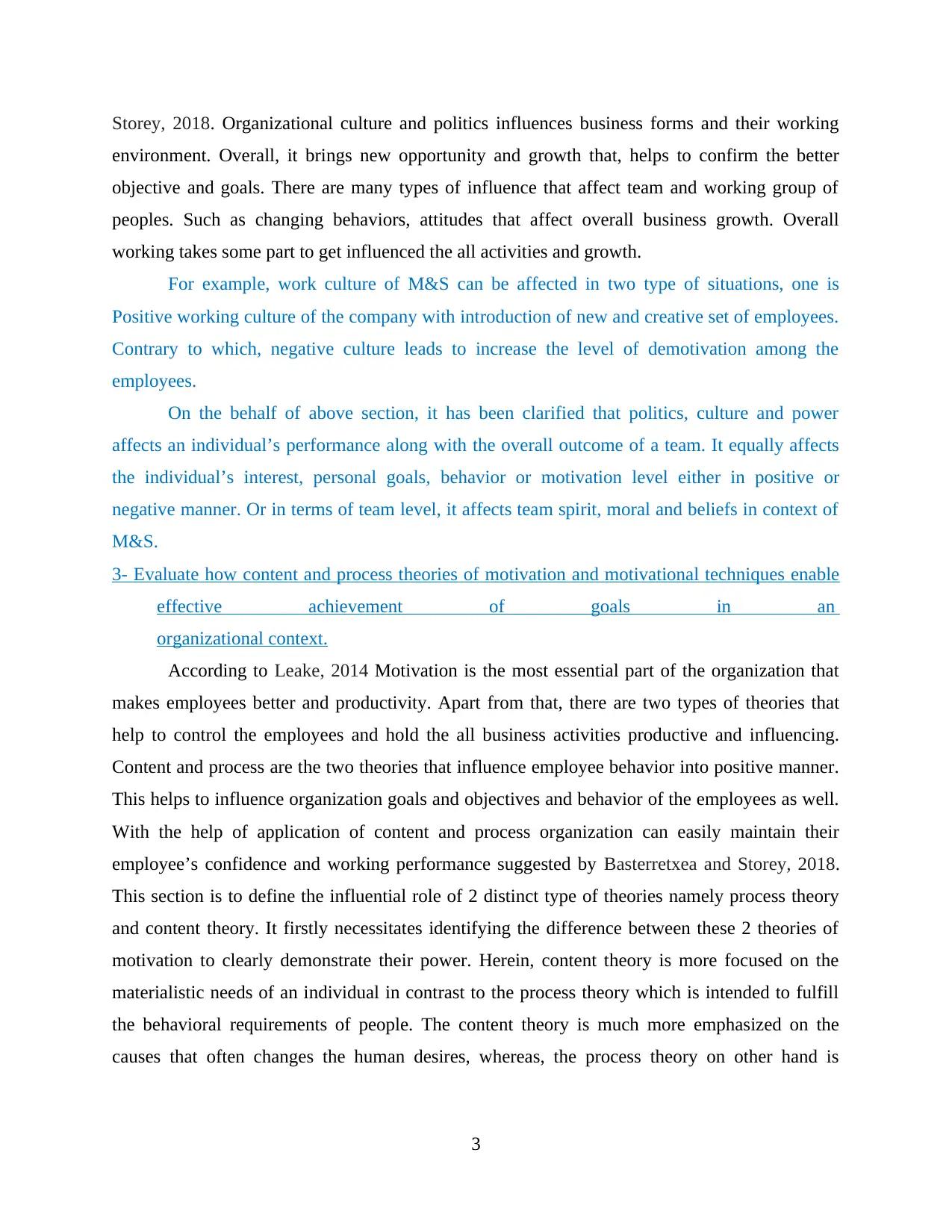
Storey, 2018. Organizational culture and politics influences business forms and their working
environment. Overall, it brings new opportunity and growth that, helps to confirm the better
objective and goals. There are many types of influence that affect team and working group of
peoples. Such as changing behaviors, attitudes that affect overall business growth. Overall
working takes some part to get influenced the all activities and growth.
For example, work culture of M&S can be affected in two type of situations, one is
Positive working culture of the company with introduction of new and creative set of employees.
Contrary to which, negative culture leads to increase the level of demotivation among the
employees.
On the behalf of above section, it has been clarified that politics, culture and power
affects an individual’s performance along with the overall outcome of a team. It equally affects
the individual’s interest, personal goals, behavior or motivation level either in positive or
negative manner. Or in terms of team level, it affects team spirit, moral and beliefs in context of
M&S.
3- Evaluate how content and process theories of motivation and motivational techniques enable
effective achievement of goals in an
organizational context.
According to Leake, 2014 Motivation is the most essential part of the organization that
makes employees better and productivity. Apart from that, there are two types of theories that
help to control the employees and hold the all business activities productive and influencing.
Content and process are the two theories that influence employee behavior into positive manner.
This helps to influence organization goals and objectives and behavior of the employees as well.
With the help of application of content and process organization can easily maintain their
employee’s confidence and working performance suggested by Basterretxea and Storey, 2018.
This section is to define the influential role of 2 distinct type of theories namely process theory
and content theory. It firstly necessitates identifying the difference between these 2 theories of
motivation to clearly demonstrate their power. Herein, content theory is more focused on the
materialistic needs of an individual in contrast to the process theory which is intended to fulfill
the behavioral requirements of people. The content theory is much more emphasized on the
causes that often changes the human desires, whereas, the process theory on other hand is
3
environment. Overall, it brings new opportunity and growth that, helps to confirm the better
objective and goals. There are many types of influence that affect team and working group of
peoples. Such as changing behaviors, attitudes that affect overall business growth. Overall
working takes some part to get influenced the all activities and growth.
For example, work culture of M&S can be affected in two type of situations, one is
Positive working culture of the company with introduction of new and creative set of employees.
Contrary to which, negative culture leads to increase the level of demotivation among the
employees.
On the behalf of above section, it has been clarified that politics, culture and power
affects an individual’s performance along with the overall outcome of a team. It equally affects
the individual’s interest, personal goals, behavior or motivation level either in positive or
negative manner. Or in terms of team level, it affects team spirit, moral and beliefs in context of
M&S.
3- Evaluate how content and process theories of motivation and motivational techniques enable
effective achievement of goals in an
organizational context.
According to Leake, 2014 Motivation is the most essential part of the organization that
makes employees better and productivity. Apart from that, there are two types of theories that
help to control the employees and hold the all business activities productive and influencing.
Content and process are the two theories that influence employee behavior into positive manner.
This helps to influence organization goals and objectives and behavior of the employees as well.
With the help of application of content and process organization can easily maintain their
employee’s confidence and working performance suggested by Basterretxea and Storey, 2018.
This section is to define the influential role of 2 distinct type of theories namely process theory
and content theory. It firstly necessitates identifying the difference between these 2 theories of
motivation to clearly demonstrate their power. Herein, content theory is more focused on the
materialistic needs of an individual in contrast to the process theory which is intended to fulfill
the behavioral requirements of people. The content theory is much more emphasized on the
causes that often changes the human desires, whereas, the process theory on other hand is
3
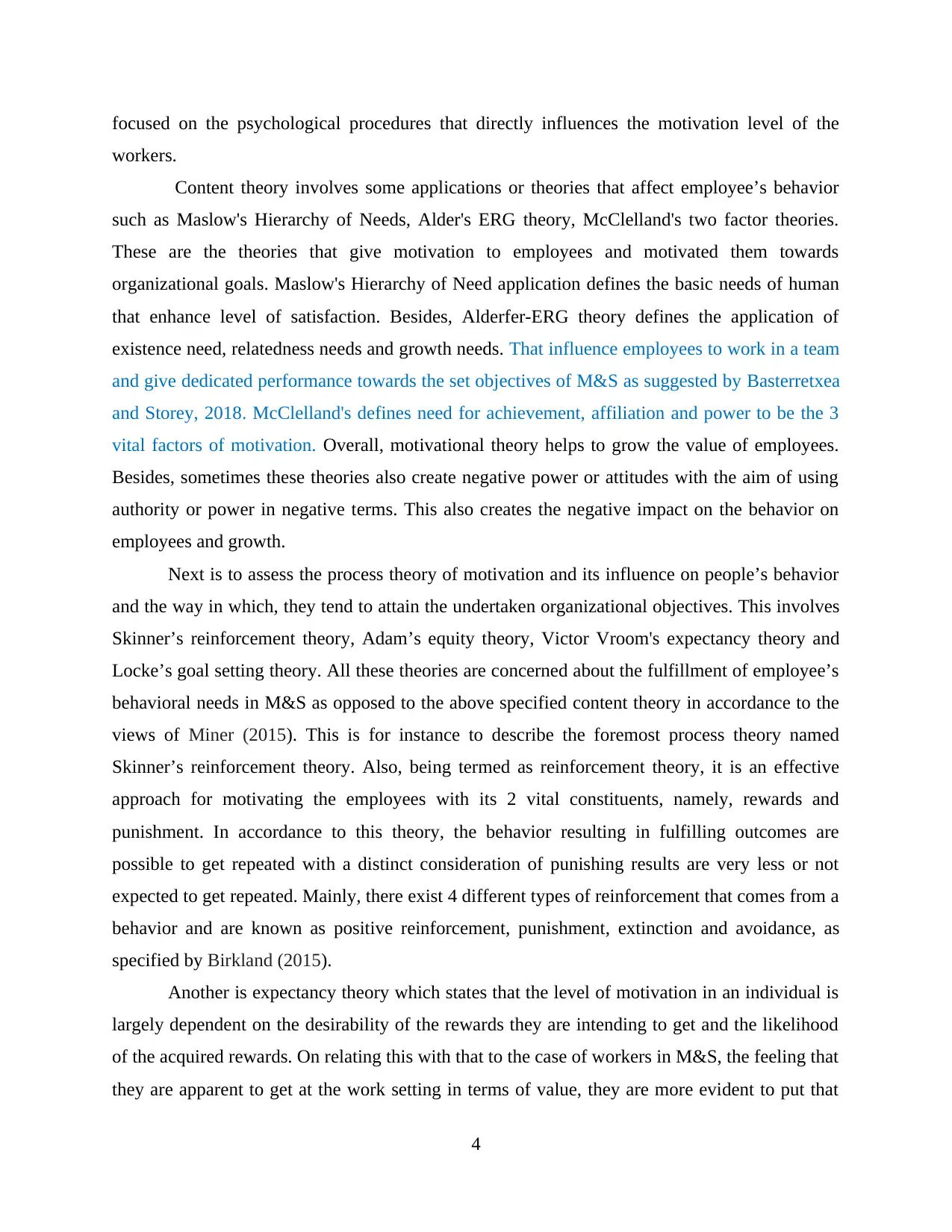
focused on the psychological procedures that directly influences the motivation level of the
workers.
Content theory involves some applications or theories that affect employee’s behavior
such as Maslow's Hierarchy of Needs, Alder's ERG theory, McClelland's two factor theories.
These are the theories that give motivation to employees and motivated them towards
organizational goals. Maslow's Hierarchy of Need application defines the basic needs of human
that enhance level of satisfaction. Besides, Alderfer-ERG theory defines the application of
existence need, relatedness needs and growth needs. That influence employees to work in a team
and give dedicated performance towards the set objectives of M&S as suggested by Basterretxea
and Storey, 2018. McClelland's defines need for achievement, affiliation and power to be the 3
vital factors of motivation. Overall, motivational theory helps to grow the value of employees.
Besides, sometimes these theories also create negative power or attitudes with the aim of using
authority or power in negative terms. This also creates the negative impact on the behavior on
employees and growth.
Next is to assess the process theory of motivation and its influence on people’s behavior
and the way in which, they tend to attain the undertaken organizational objectives. This involves
Skinner’s reinforcement theory, Adam’s equity theory, Victor Vroom's expectancy theory and
Locke’s goal setting theory. All these theories are concerned about the fulfillment of employee’s
behavioral needs in M&S as opposed to the above specified content theory in accordance to the
views of Miner (2015). This is for instance to describe the foremost process theory named
Skinner’s reinforcement theory. Also, being termed as reinforcement theory, it is an effective
approach for motivating the employees with its 2 vital constituents, namely, rewards and
punishment. In accordance to this theory, the behavior resulting in fulfilling outcomes are
possible to get repeated with a distinct consideration of punishing results are very less or not
expected to get repeated. Mainly, there exist 4 different types of reinforcement that comes from a
behavior and are known as positive reinforcement, punishment, extinction and avoidance, as
specified by Birkland (2015).
Another is expectancy theory which states that the level of motivation in an individual is
largely dependent on the desirability of the rewards they are intending to get and the likelihood
of the acquired rewards. On relating this with that to the case of workers in M&S, the feeling that
they are apparent to get at the work setting in terms of value, they are more evident to put that
4
workers.
Content theory involves some applications or theories that affect employee’s behavior
such as Maslow's Hierarchy of Needs, Alder's ERG theory, McClelland's two factor theories.
These are the theories that give motivation to employees and motivated them towards
organizational goals. Maslow's Hierarchy of Need application defines the basic needs of human
that enhance level of satisfaction. Besides, Alderfer-ERG theory defines the application of
existence need, relatedness needs and growth needs. That influence employees to work in a team
and give dedicated performance towards the set objectives of M&S as suggested by Basterretxea
and Storey, 2018. McClelland's defines need for achievement, affiliation and power to be the 3
vital factors of motivation. Overall, motivational theory helps to grow the value of employees.
Besides, sometimes these theories also create negative power or attitudes with the aim of using
authority or power in negative terms. This also creates the negative impact on the behavior on
employees and growth.
Next is to assess the process theory of motivation and its influence on people’s behavior
and the way in which, they tend to attain the undertaken organizational objectives. This involves
Skinner’s reinforcement theory, Adam’s equity theory, Victor Vroom's expectancy theory and
Locke’s goal setting theory. All these theories are concerned about the fulfillment of employee’s
behavioral needs in M&S as opposed to the above specified content theory in accordance to the
views of Miner (2015). This is for instance to describe the foremost process theory named
Skinner’s reinforcement theory. Also, being termed as reinforcement theory, it is an effective
approach for motivating the employees with its 2 vital constituents, namely, rewards and
punishment. In accordance to this theory, the behavior resulting in fulfilling outcomes are
possible to get repeated with a distinct consideration of punishing results are very less or not
expected to get repeated. Mainly, there exist 4 different types of reinforcement that comes from a
behavior and are known as positive reinforcement, punishment, extinction and avoidance, as
specified by Birkland (2015).
Another is expectancy theory which states that the level of motivation in an individual is
largely dependent on the desirability of the rewards they are intending to get and the likelihood
of the acquired rewards. On relating this with that to the case of workers in M&S, the feeling that
they are apparent to get at the work setting in terms of value, they are more evident to put that
4
⊘ This is a preview!⊘
Do you want full access?
Subscribe today to unlock all pages.

Trusted by 1+ million students worldwide
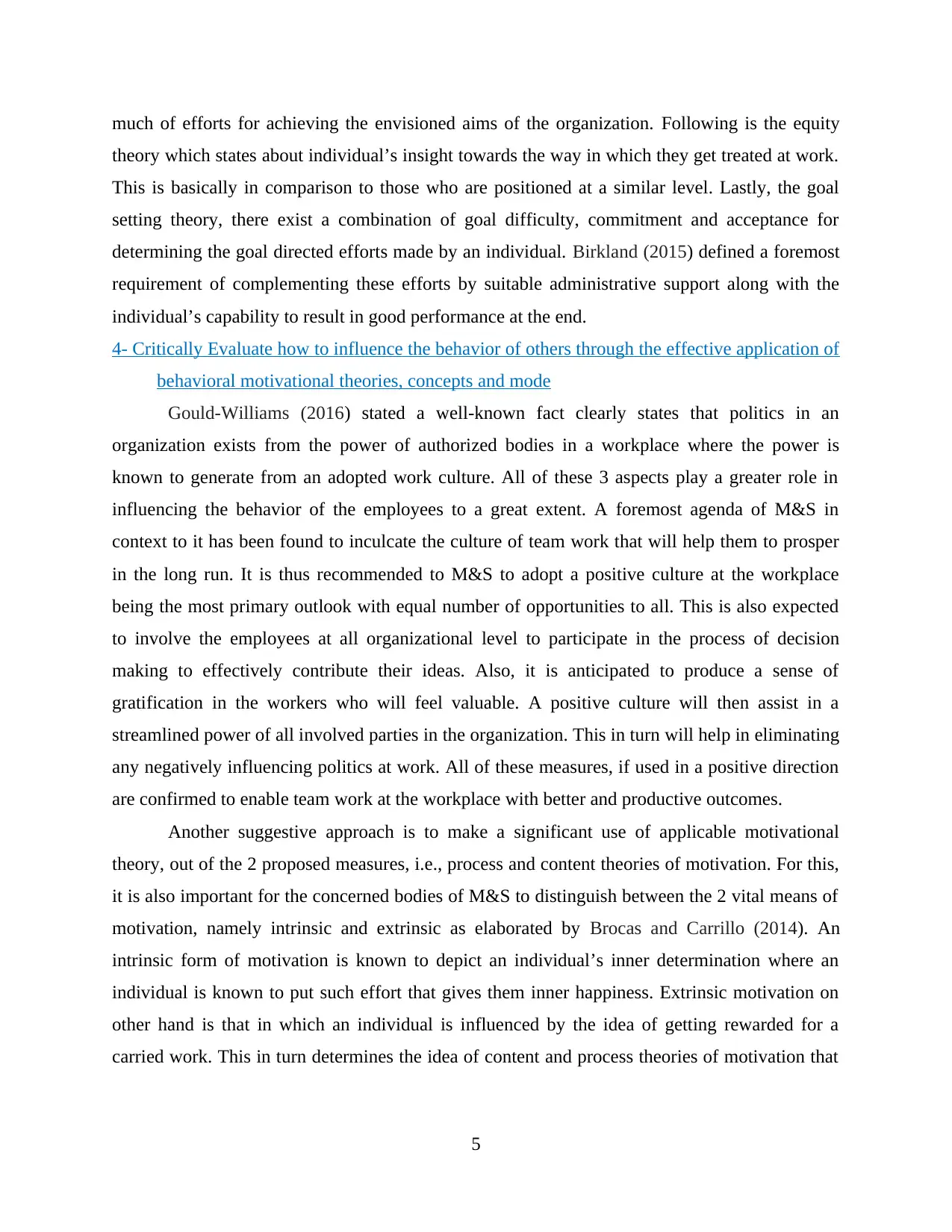
much of efforts for achieving the envisioned aims of the organization. Following is the equity
theory which states about individual’s insight towards the way in which they get treated at work.
This is basically in comparison to those who are positioned at a similar level. Lastly, the goal
setting theory, there exist a combination of goal difficulty, commitment and acceptance for
determining the goal directed efforts made by an individual. Birkland (2015) defined a foremost
requirement of complementing these efforts by suitable administrative support along with the
individual’s capability to result in good performance at the end.
4- Critically Evaluate how to influence the behavior of others through the effective application of
behavioral motivational theories, concepts and mode
Gould-Williams (2016) stated a well-known fact clearly states that politics in an
organization exists from the power of authorized bodies in a workplace where the power is
known to generate from an adopted work culture. All of these 3 aspects play a greater role in
influencing the behavior of the employees to a great extent. A foremost agenda of M&S in
context to it has been found to inculcate the culture of team work that will help them to prosper
in the long run. It is thus recommended to M&S to adopt a positive culture at the workplace
being the most primary outlook with equal number of opportunities to all. This is also expected
to involve the employees at all organizational level to participate in the process of decision
making to effectively contribute their ideas. Also, it is anticipated to produce a sense of
gratification in the workers who will feel valuable. A positive culture will then assist in a
streamlined power of all involved parties in the organization. This in turn will help in eliminating
any negatively influencing politics at work. All of these measures, if used in a positive direction
are confirmed to enable team work at the workplace with better and productive outcomes.
Another suggestive approach is to make a significant use of applicable motivational
theory, out of the 2 proposed measures, i.e., process and content theories of motivation. For this,
it is also important for the concerned bodies of M&S to distinguish between the 2 vital means of
motivation, namely intrinsic and extrinsic as elaborated by Brocas and Carrillo (2014). An
intrinsic form of motivation is known to depict an individual’s inner determination where an
individual is known to put such effort that gives them inner happiness. Extrinsic motivation on
other hand is that in which an individual is influenced by the idea of getting rewarded for a
carried work. This in turn determines the idea of content and process theories of motivation that
5
theory which states about individual’s insight towards the way in which they get treated at work.
This is basically in comparison to those who are positioned at a similar level. Lastly, the goal
setting theory, there exist a combination of goal difficulty, commitment and acceptance for
determining the goal directed efforts made by an individual. Birkland (2015) defined a foremost
requirement of complementing these efforts by suitable administrative support along with the
individual’s capability to result in good performance at the end.
4- Critically Evaluate how to influence the behavior of others through the effective application of
behavioral motivational theories, concepts and mode
Gould-Williams (2016) stated a well-known fact clearly states that politics in an
organization exists from the power of authorized bodies in a workplace where the power is
known to generate from an adopted work culture. All of these 3 aspects play a greater role in
influencing the behavior of the employees to a great extent. A foremost agenda of M&S in
context to it has been found to inculcate the culture of team work that will help them to prosper
in the long run. It is thus recommended to M&S to adopt a positive culture at the workplace
being the most primary outlook with equal number of opportunities to all. This is also expected
to involve the employees at all organizational level to participate in the process of decision
making to effectively contribute their ideas. Also, it is anticipated to produce a sense of
gratification in the workers who will feel valuable. A positive culture will then assist in a
streamlined power of all involved parties in the organization. This in turn will help in eliminating
any negatively influencing politics at work. All of these measures, if used in a positive direction
are confirmed to enable team work at the workplace with better and productive outcomes.
Another suggestive approach is to make a significant use of applicable motivational
theory, out of the 2 proposed measures, i.e., process and content theories of motivation. For this,
it is also important for the concerned bodies of M&S to distinguish between the 2 vital means of
motivation, namely intrinsic and extrinsic as elaborated by Brocas and Carrillo (2014). An
intrinsic form of motivation is known to depict an individual’s inner determination where an
individual is known to put such effort that gives them inner happiness. Extrinsic motivation on
other hand is that in which an individual is influenced by the idea of getting rewarded for a
carried work. This in turn determines the idea of content and process theories of motivation that
5
Paraphrase This Document
Need a fresh take? Get an instant paraphrase of this document with our AI Paraphraser
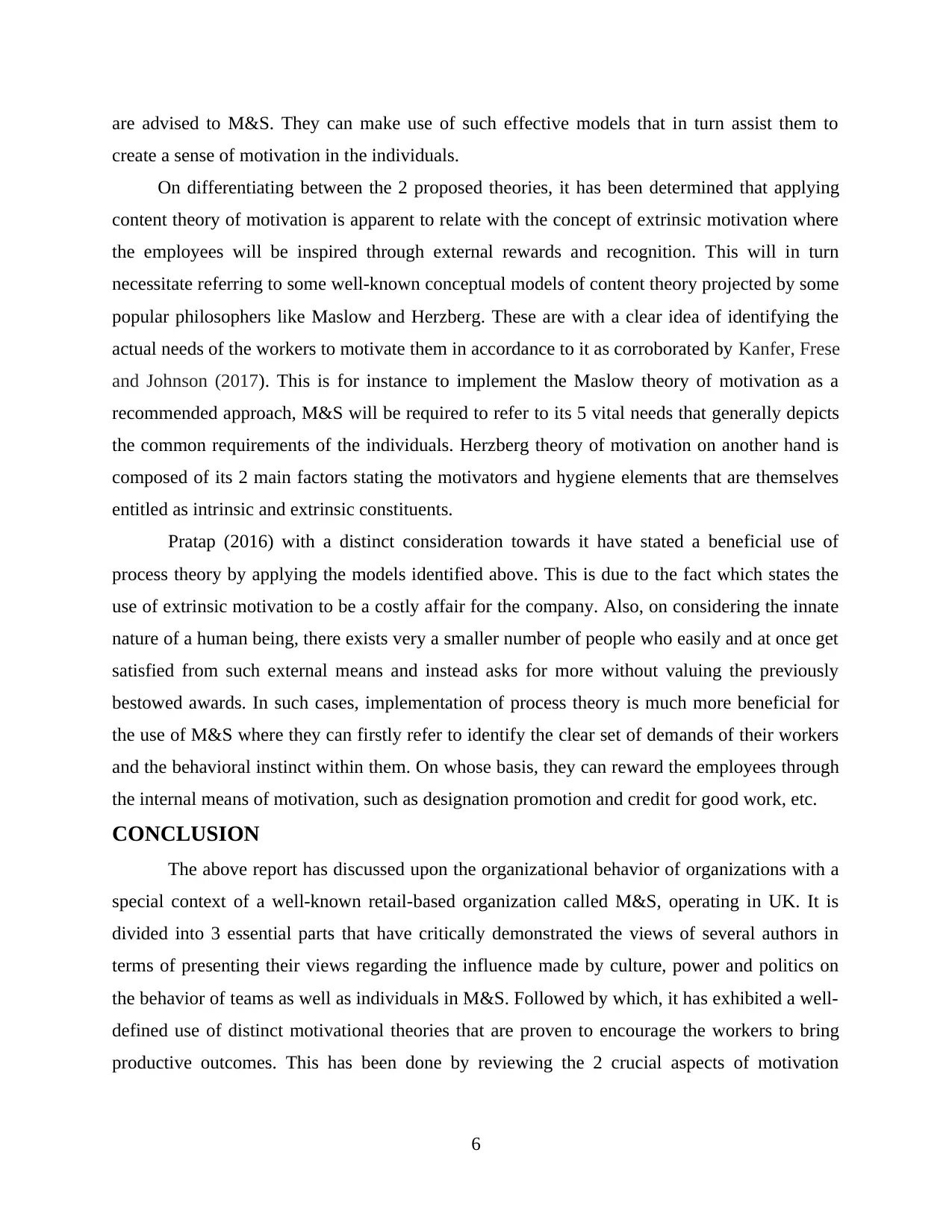
are advised to M&S. They can make use of such effective models that in turn assist them to
create a sense of motivation in the individuals.
On differentiating between the 2 proposed theories, it has been determined that applying
content theory of motivation is apparent to relate with the concept of extrinsic motivation where
the employees will be inspired through external rewards and recognition. This will in turn
necessitate referring to some well-known conceptual models of content theory projected by some
popular philosophers like Maslow and Herzberg. These are with a clear idea of identifying the
actual needs of the workers to motivate them in accordance to it as corroborated by Kanfer, Frese
and Johnson (2017). This is for instance to implement the Maslow theory of motivation as a
recommended approach, M&S will be required to refer to its 5 vital needs that generally depicts
the common requirements of the individuals. Herzberg theory of motivation on another hand is
composed of its 2 main factors stating the motivators and hygiene elements that are themselves
entitled as intrinsic and extrinsic constituents.
Pratap (2016) with a distinct consideration towards it have stated a beneficial use of
process theory by applying the models identified above. This is due to the fact which states the
use of extrinsic motivation to be a costly affair for the company. Also, on considering the innate
nature of a human being, there exists very a smaller number of people who easily and at once get
satisfied from such external means and instead asks for more without valuing the previously
bestowed awards. In such cases, implementation of process theory is much more beneficial for
the use of M&S where they can firstly refer to identify the clear set of demands of their workers
and the behavioral instinct within them. On whose basis, they can reward the employees through
the internal means of motivation, such as designation promotion and credit for good work, etc.
CONCLUSION
The above report has discussed upon the organizational behavior of organizations with a
special context of a well-known retail-based organization called M&S, operating in UK. It is
divided into 3 essential parts that have critically demonstrated the views of several authors in
terms of presenting their views regarding the influence made by culture, power and politics on
the behavior of teams as well as individuals in M&S. Followed by which, it has exhibited a well-
defined use of distinct motivational theories that are proven to encourage the workers to bring
productive outcomes. This has been done by reviewing the 2 crucial aspects of motivation
6
create a sense of motivation in the individuals.
On differentiating between the 2 proposed theories, it has been determined that applying
content theory of motivation is apparent to relate with the concept of extrinsic motivation where
the employees will be inspired through external rewards and recognition. This will in turn
necessitate referring to some well-known conceptual models of content theory projected by some
popular philosophers like Maslow and Herzberg. These are with a clear idea of identifying the
actual needs of the workers to motivate them in accordance to it as corroborated by Kanfer, Frese
and Johnson (2017). This is for instance to implement the Maslow theory of motivation as a
recommended approach, M&S will be required to refer to its 5 vital needs that generally depicts
the common requirements of the individuals. Herzberg theory of motivation on another hand is
composed of its 2 main factors stating the motivators and hygiene elements that are themselves
entitled as intrinsic and extrinsic constituents.
Pratap (2016) with a distinct consideration towards it have stated a beneficial use of
process theory by applying the models identified above. This is due to the fact which states the
use of extrinsic motivation to be a costly affair for the company. Also, on considering the innate
nature of a human being, there exists very a smaller number of people who easily and at once get
satisfied from such external means and instead asks for more without valuing the previously
bestowed awards. In such cases, implementation of process theory is much more beneficial for
the use of M&S where they can firstly refer to identify the clear set of demands of their workers
and the behavioral instinct within them. On whose basis, they can reward the employees through
the internal means of motivation, such as designation promotion and credit for good work, etc.
CONCLUSION
The above report has discussed upon the organizational behavior of organizations with a
special context of a well-known retail-based organization called M&S, operating in UK. It is
divided into 3 essential parts that have critically demonstrated the views of several authors in
terms of presenting their views regarding the influence made by culture, power and politics on
the behavior of teams as well as individuals in M&S. Followed by which, it has exhibited a well-
defined use of distinct motivational theories that are proven to encourage the workers to bring
productive outcomes. This has been done by reviewing the 2 crucial aspects of motivation
6
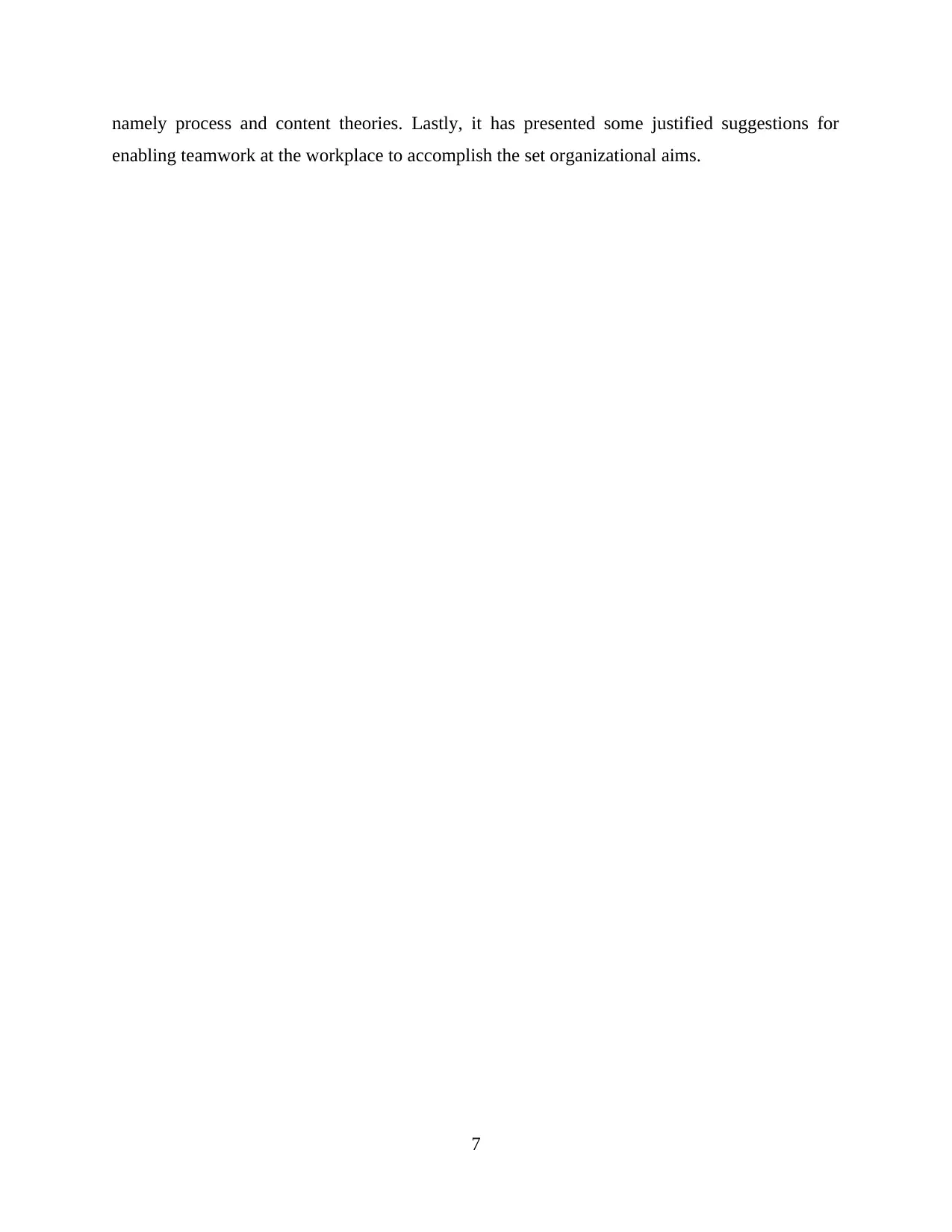
namely process and content theories. Lastly, it has presented some justified suggestions for
enabling teamwork at the workplace to accomplish the set organizational aims.
7
enabling teamwork at the workplace to accomplish the set organizational aims.
7
⊘ This is a preview!⊘
Do you want full access?
Subscribe today to unlock all pages.

Trusted by 1+ million students worldwide
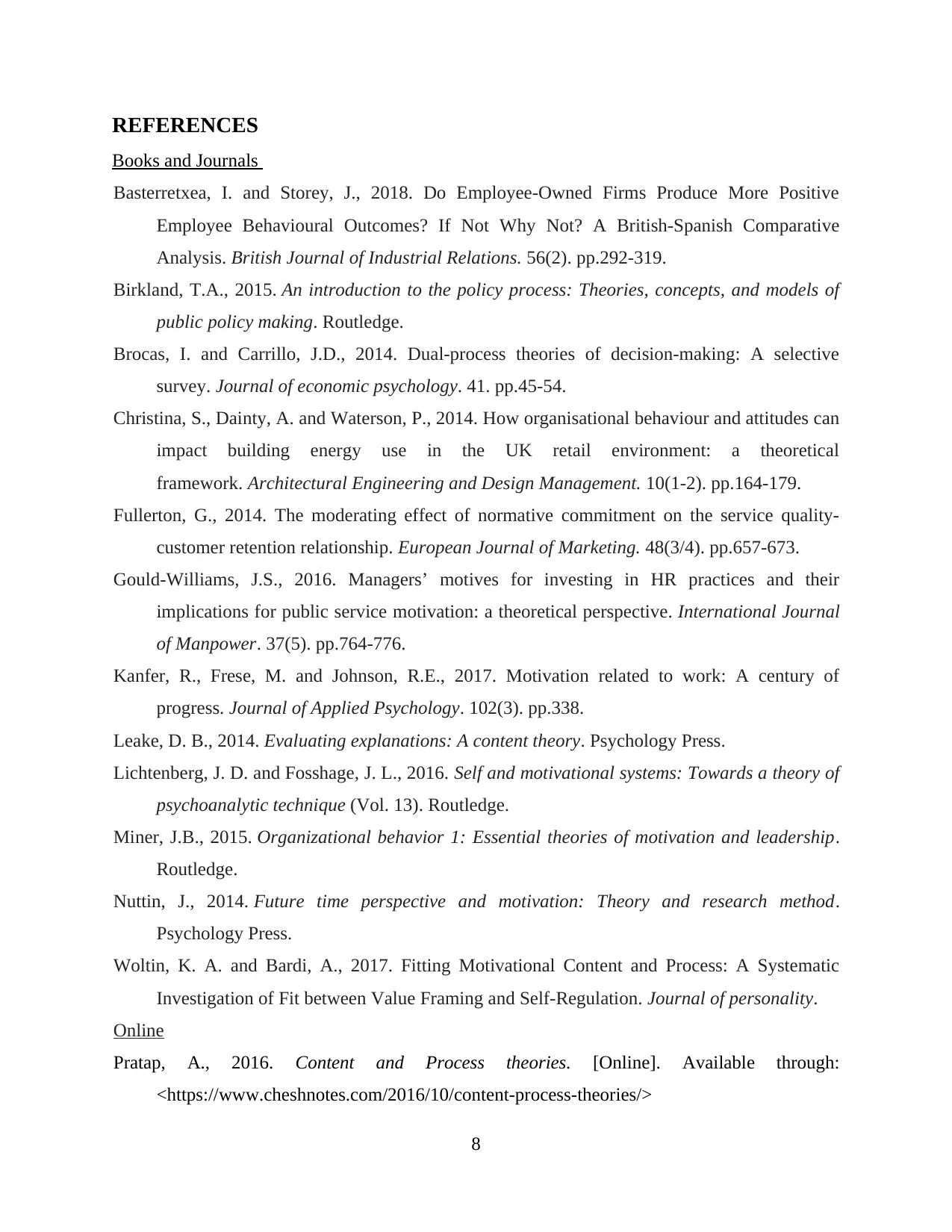
REFERENCES
Books and Journals
Basterretxea, I. and Storey, J., 2018. Do Employee‐Owned Firms Produce More Positive
Employee Behavioural Outcomes? If Not Why Not? A British‐Spanish Comparative
Analysis. British Journal of Industrial Relations. 56(2). pp.292-319.
Birkland, T.A., 2015. An introduction to the policy process: Theories, concepts, and models of
public policy making. Routledge.
Brocas, I. and Carrillo, J.D., 2014. Dual-process theories of decision-making: A selective
survey. Journal of economic psychology. 41. pp.45-54.
Christina, S., Dainty, A. and Waterson, P., 2014. How organisational behaviour and attitudes can
impact building energy use in the UK retail environment: a theoretical
framework. Architectural Engineering and Design Management. 10(1-2). pp.164-179.
Fullerton, G., 2014. The moderating effect of normative commitment on the service quality-
customer retention relationship. European Journal of Marketing. 48(3/4). pp.657-673.
Gould-Williams, J.S., 2016. Managers’ motives for investing in HR practices and their
implications for public service motivation: a theoretical perspective. International Journal
of Manpower. 37(5). pp.764-776.
Kanfer, R., Frese, M. and Johnson, R.E., 2017. Motivation related to work: A century of
progress. Journal of Applied Psychology. 102(3). pp.338.
Leake, D. B., 2014. Evaluating explanations: A content theory. Psychology Press.
Lichtenberg, J. D. and Fosshage, J. L., 2016. Self and motivational systems: Towards a theory of
psychoanalytic technique (Vol. 13). Routledge.
Miner, J.B., 2015. Organizational behavior 1: Essential theories of motivation and leadership.
Routledge.
Nuttin, J., 2014. Future time perspective and motivation: Theory and research method.
Psychology Press.
Woltin, K. A. and Bardi, A., 2017. Fitting Motivational Content and Process: A Systematic
Investigation of Fit between Value Framing and Self‐Regulation. Journal of personality.
Online
Pratap, A., 2016. Content and Process theories. [Online]. Available through:
<https://www.cheshnotes.com/2016/10/content-process-theories/>
8
Books and Journals
Basterretxea, I. and Storey, J., 2018. Do Employee‐Owned Firms Produce More Positive
Employee Behavioural Outcomes? If Not Why Not? A British‐Spanish Comparative
Analysis. British Journal of Industrial Relations. 56(2). pp.292-319.
Birkland, T.A., 2015. An introduction to the policy process: Theories, concepts, and models of
public policy making. Routledge.
Brocas, I. and Carrillo, J.D., 2014. Dual-process theories of decision-making: A selective
survey. Journal of economic psychology. 41. pp.45-54.
Christina, S., Dainty, A. and Waterson, P., 2014. How organisational behaviour and attitudes can
impact building energy use in the UK retail environment: a theoretical
framework. Architectural Engineering and Design Management. 10(1-2). pp.164-179.
Fullerton, G., 2014. The moderating effect of normative commitment on the service quality-
customer retention relationship. European Journal of Marketing. 48(3/4). pp.657-673.
Gould-Williams, J.S., 2016. Managers’ motives for investing in HR practices and their
implications for public service motivation: a theoretical perspective. International Journal
of Manpower. 37(5). pp.764-776.
Kanfer, R., Frese, M. and Johnson, R.E., 2017. Motivation related to work: A century of
progress. Journal of Applied Psychology. 102(3). pp.338.
Leake, D. B., 2014. Evaluating explanations: A content theory. Psychology Press.
Lichtenberg, J. D. and Fosshage, J. L., 2016. Self and motivational systems: Towards a theory of
psychoanalytic technique (Vol. 13). Routledge.
Miner, J.B., 2015. Organizational behavior 1: Essential theories of motivation and leadership.
Routledge.
Nuttin, J., 2014. Future time perspective and motivation: Theory and research method.
Psychology Press.
Woltin, K. A. and Bardi, A., 2017. Fitting Motivational Content and Process: A Systematic
Investigation of Fit between Value Framing and Self‐Regulation. Journal of personality.
Online
Pratap, A., 2016. Content and Process theories. [Online]. Available through:
<https://www.cheshnotes.com/2016/10/content-process-theories/>
8
1 out of 10
Related Documents
Your All-in-One AI-Powered Toolkit for Academic Success.
+13062052269
info@desklib.com
Available 24*7 on WhatsApp / Email
![[object Object]](/_next/static/media/star-bottom.7253800d.svg)
Unlock your academic potential
Copyright © 2020–2025 A2Z Services. All Rights Reserved. Developed and managed by ZUCOL.



